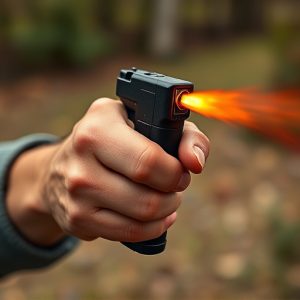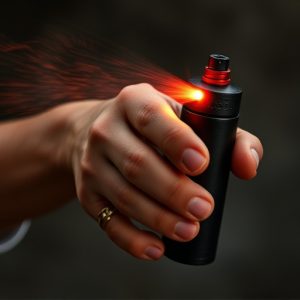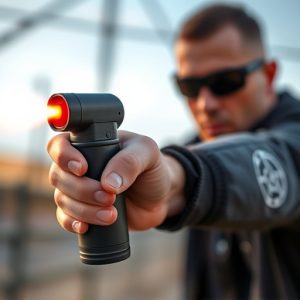Crowd Control Pepper Spray: Science, Safety & Effective Techniques
Crowd Control Pepper Spray Techniques are essential tools for police officers, requiring strategic d…….
Crowd Control Pepper Spray Techniques are essential tools for police officers, requiring strategic deployment and thorough training. The techniques cater to diverse crowd scenarios, with considerations like age, culture, and behavior. These tactics leverage science-backed ingredients, such as capsaicin, and precise application methods to temporarily disable individuals without causing long-term harm. Effective use involves targeted areas, wind awareness, and suitable canister choices. Law enforcement agencies must prioritize safety and responsible force usage, adhering to legal and ethical guidelines, and ensuring de-escalation strategies are exhaustively practiced for minimal collateral damage and civil rights protection.
In the realm of crowd control, police-grade inflammatory pepper spray compounds have emerged as a significant tool. Understanding the dynamics of crowds and the science behind these potent agents is crucial for maximizing their effectiveness while ensuring safe deployment. This article delves into the understanding of crowd behavior, the scientific composition of pepper spray, optimal deployment techniques, safety considerations, legal implications, and ethical use in various situations, highlighting the key Crowd Control Pepper Spray Techniques.
- Understanding Crowd Dynamics and the Role of Pepper Spray
- The Science Behind Police-Grade Inflammatory Pepper Spray Compounds
- Effective Deployment Techniques for Maximized Impact
- Safety Considerations and Training for Law Enforcement Officers
- Legal Implications and Ethical Use in Crowd Control Situations
Understanding Crowd Dynamics and the Role of Pepper Spray
Understanding crowd dynamics is paramount when discussing crowd control pepper spray techniques. Crowds can vary greatly in size, composition, and behavior, making one-size-fits-all strategies ineffective. Police officers must be adept at assessing crowd characteristics, such as their age, cultural backgrounds, and motivations, to deploy the appropriate tactics. For instance, a peaceful protest may require a different approach than a rioting mob, where crowd control pepper spray can play a pivotal role in maintaining public safety.
Pepper spray, also known as oleoresin capsicum (OC) spray, is a powerful tool for crowd control due to its ability to quickly incapacitate individuals by temporarily blinding them and causing intense pain. This non-lethal agent allows officers to gain control of disruptive crowds, allowing for safer management and resolution of the situation. Effective use of pepper spray requires training and strategy, ensuring that it’s used as a last resort when other crowd control measures have failed or are inappropriate.
The Science Behind Police-Grade Inflammatory Pepper Spray Compounds
Police-grade inflammatory pepper spray compounds are designed using advanced scientific principles and formulations to ensure their effectiveness in crowd control scenarios. These specialized sprays harness the power of capsaicinoids, the active ingredients found in chili peppers, to create a potent irritant that disrupts normal bodily functions when came into contact with eyes, skin, or mucous membranes. The science behind these compounds involves precise adjustments in capsaicin concentration and delivery mechanisms to balance potency with safety for both suspects and officers.
Crowd control pepper spray techniques leverage the physical and chemical properties of these compounds. For instance, specialized nozzles and atomization processes enable uniform dispersal of the spray, maximizing its impact area while minimizing off-target effects. Additionally, research into inhalation toxicity and skin permeation helps in setting safe usage guidelines, ensuring that these powerful tools are employed responsibly. This meticulous combination of chemistry, physics, and tactical strategy underpins the effectiveness of police-grade inflammatory pepper spray compounds in crowd control operations.
Effective Deployment Techniques for Maximized Impact
When employing crowd control pepper spray techniques, strategic deployment is key to maximizing its impact. Officers should aim for the eyes, nose, and mouth—sensitive areas that will quickly disable an individual’s ability to see, breathe, and fight back. A precise, targeted approach is more effective than spraying broadly, as it reduces the risk of harming bystanders or causing unnecessary damage.
Furthermore, training in proper application techniques, including wind considerations and distance, is crucial. Officers should also be equipped with the appropriate spray canisters designed for crowd control scenarios, ensuring a high concentration of capsaicin to neutralise threats efficiently. Utilizing these Crowd Control Pepper Spray Techniques requires discipline, practice, and an understanding of the unique challenges presented in various situations.
Safety Considerations and Training for Law Enforcement Officers
When employing crowd control pepper spray techniques, law enforcement officers must prioritize safety above all else. Proper training is essential to ensure that officers understand the risks associated with using such force and can do so responsibly. This includes learning about the different types of pepper spray compounds, their effects on various individuals, and how to administer them effectively while minimizing collateral damage. Officers should also be taught de-escalation strategies, as deploying pepper spray should always be a last resort.
Regular practice sessions are crucial for maintaining proficiency in crowd control tactics. Through simulated scenarios, officers can hone their skills in managing different crowds, identifying potential risks, and selecting the appropriate crowd control pepper spray techniques. This training not only enhances individual performance but also fosters a culture of safety within the force, ensuring that every officer is prepared to handle high-pressure situations with professionalism and restraint.
Legal Implications and Ethical Use in Crowd Control Situations
The legal implications surrounding the use of crowd control pepper spray are complex and vary significantly across jurisdictions. Law enforcement agencies must adhere to strict protocols and guidelines, ensuring that its application is proportional, necessary, and in accordance with existing laws. Failure to do so can result in severe consequences, including civil lawsuits for excessive force and potential criminal charges for misconduct. The ethical considerations are equally profound, especially when dealing with non-violent protesters or civil disobedience.
In crowd control situations, pepper spray techniques must be employed cautiously and responsibly. While it can effectively disrupt large gatherings, its misuse can lead to widespread panic, injuries, and even fatalities. Law enforcement must balance the need for maintaining public order with the obligation to protect the rights of individuals, ensuring that crowd control measures, including pepper spray, are used as a last resort and in line with established best practices and international human rights standards.
Police-grade inflammatory pepper spray compounds play a significant role in crowd control situations, offering effective techniques for managing large gatherings. Understanding the science behind these compounds, their optimal deployment strategies, and safety considerations is paramount for law enforcement officers. By adhering to ethical use guidelines and ensuring proper training, these tools can be utilized responsibly, balancing public safety with minimal harm. In the realm of crowd control pepper spray techniques, ongoing research and responsible implementation are key to maintaining a delicate balance during critical incidents.


